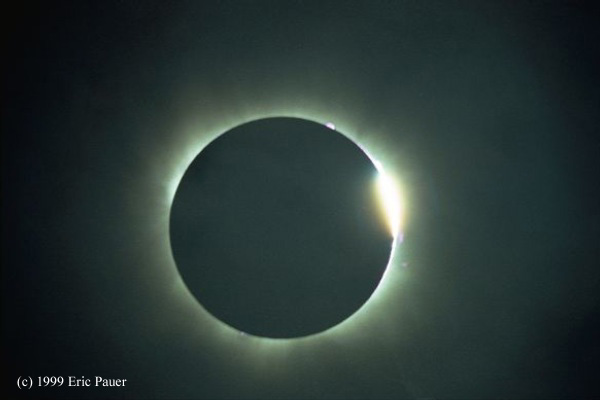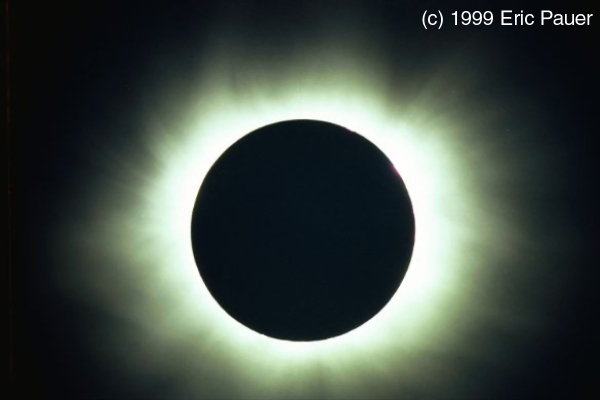
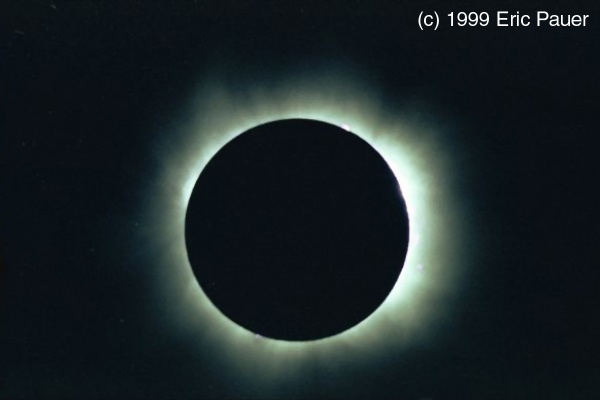
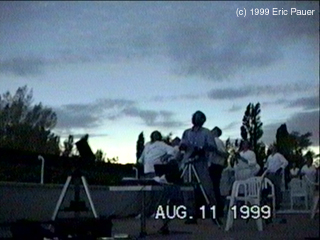



With the naked eye, my first impression, as I stared
in awe at the totally eclipsed sun, was that I was looking at a jeweled
bracelet high in the sky. The “jewels” of the bracelet were the numerous
red-orange prominences visible around the eclipsed sun. The only
blemish in the otherwise perfect view was a high thin cloud layer that
did obscure some of the outer corona. However, the middle portion
of the corona out to about a solar diameter could be seen, and there was
an excellent view of the bright inner corona. The corona was very
symmetric and had a fine living quality to it, with thin pearly lines slowly
dancing back and forth, decorated with its embedded red-orange jewels.
Instead of the outer corona, in its place we could see a rainbow-like halo,
like one might see around a full moon with thin clouds. Looking back,
I think these clouds probably also made the prominences even more conspicuous.
To the lower left of the corona, I clearly saw Venus shining brightly in
the twilight darkened sky (magnitude –3.5). I did not see Mercury
(magnitude +0.7), as it was probably hidden behind the cloud layer.
I heard the two cameras clicking away taking photos as planning, hoping
they were capturing the event as planned. Some of the hotel staff
noticed the Hungarian fighter jet racing along with the lunar shadow high
in the sky, trying to keep up with the silent curtain of darkness.
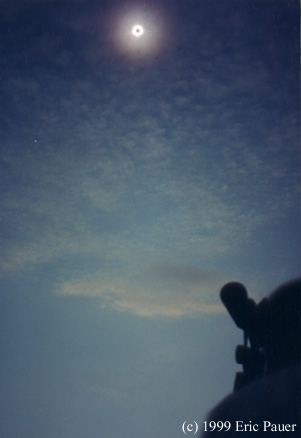
While gazing at the remarkable sight in the sky, I
somehow removed the solar filters from my tripod-mounted 10x50 binoculars
so I could get a close up view of the corona. I was blown away!
There were some earth-sized prominences on the right limb on the sun/moon
(at the 3 o’clock position) were clearly detached from the sun floating
in space—spectacular! I spent a good thirty seconds admiring this
rare spectacle of totality close up through the binoculars. It was
apparent that our beautiful view of the corona and accompanying prominences
was benefiting from the approaching solar
maximum in the year 2000. I jumped up from my binoculars to appreciate
the view of the beautiful sky during totality. The 360 degree sunset
effect was also very noticeable and stunning. The sky was steel gray
and deep/dark blue at the zenith and near the corona, then light blue to
yellow to salmon red color as one went from the corona down to the horizon.
Sunset all around! Low in the southwest, I could see the bright winter
star Sirius shining at magnitude –1.5 in a yellow portion of the sky.
I also noticed a number of birds very active during this mid-day darkness,
probably taking advantage of the insects who were faked into thinking it
was now evening. In addition, there was a person flying their ultralight
aircraft to the south, accented by their craft's blinking red light.
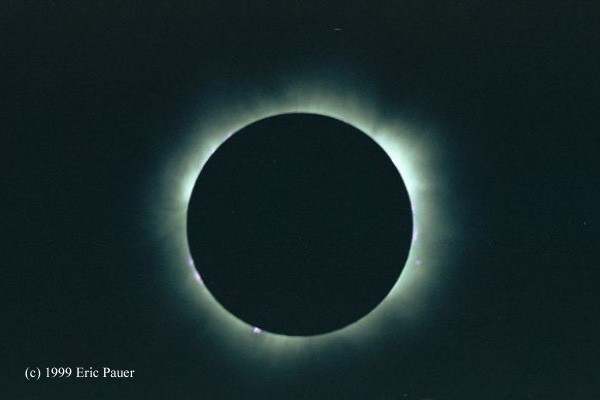
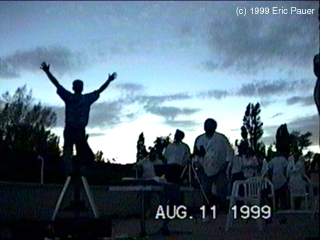
I had to chase one of the hotel staff away from my
binoculars so I could take a second close up look. The corona was
alive and the prominences were unbelievable. It was truly a moment in time
that you want to capture and never end. Even though only 30 seconds
or so had elapsed since my first view through the binoculars, the prominences
on the lower right side had now come into better view as the moon’s black
disk moved slowly to the lower left while still covering the sun’s bright
photosphere. I again jumped up to appreciate the sky and spontaneously
proclaimed “total eclipse of the sun”. I then stood on a bench near
the edge of the balcony, and I outstretched my arms first horizontally
then vertically rotating around the horizon, savoring the special glory
of totality. I absorbed the view of the corona, sky, Venus, horizon,
and unique lighting which can only be experienced during a total solar
eclipse. The rapidly lightening western horizon then became very
noticeable, alerting me that the end of totality was near. Distant
clouds to the west were already white, i.e. outside of the moon’s shadow.
A quick look at the countdown timer on the laptop indicated 15 seconds
until third contact and the end of totality. I ran to east section
of the balcony, yelling a “yee-ha” in the process. I looked up and
saw the red chromosphere followed quickly by the diamond ring, which appeared
at about the two o’clock position on the moon’s disk. The time was
12:51:10 am, third contact and the end of totality. The diamond ring
quickly became very bright, which I attribute to our centerline position
in the path of totality. I looked to the east across Lake Balaton
to see the rapidly moving edge of the moon’s shadow on the ground and in
the clouds, racing away to the next lucky souls further along its path
in Romania, Turkey, and beyond. Our group leader down below on the
grass fell over backwards in his chair in celebration of what we just saw.
There was applause and shouts of joy from the remarkable spectacle we just
experienced. Our two minutes and twenty-two seconds of totality sure
went by quick, but was very memorable.
